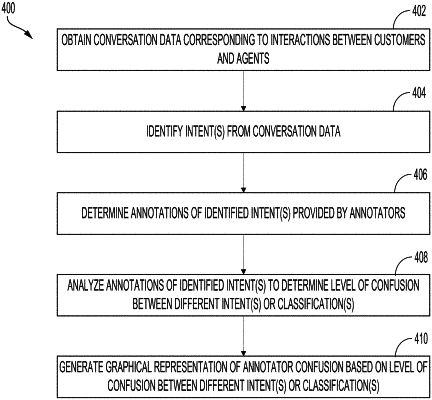| CPC G06Q 30/016 (2013.01) [G06F 40/169 (2020.01); G06F 40/35 (2020.01); G06T 11/206 (2013.01); H04L 51/04 (2013.01)] | 21 Claims |

|
1. A computer-implemented method comprising:
receiving ongoing conversation data corresponding to one or more conversations, wherein the ongoing conversation data includes annotations associated with messages exchanged during the one or more conversations, and wherein the annotations specify intents;
dynamically calculating a set of metrics in real-time, wherein the set of metrics is calculated in real-time as the ongoing conversation data is received, wherein the set of metrics is calculated based on the annotations, and wherein the set of metrics corresponds to confusion amounts between pairings of intents;
dynamically updating in real-time a graphical representation as the ongoing conversation data is received, wherein the graphical representation depicts confusion amounts between pairs of nodes using a set of edges, wherein a node corresponds to an intent, and wherein an edge corresponds to a confusion amount between a pairing of intents represented using a pair of nodes;
receiving a request to consolidate two or more intents into a single intent, wherein the two or more intents are graphically represented using a set of nodes in the graphical representation;
recalculating the set of metrics, wherein the set of metrics are recalculated by determining new confusion amounts between the single intent and one or more other intents, and wherein the one or more other intents are graphically represented using one or more other nodes in the graphical representation;
consolidating the set of nodes in the graphical representation into a single node in the graphical representation, wherein the single node corresponds to the single intent; and
generating new edges between the single node and remaining nodes in the graphical representation to indicate the new confusion amounts between the single intent and the one or more other intents.
|